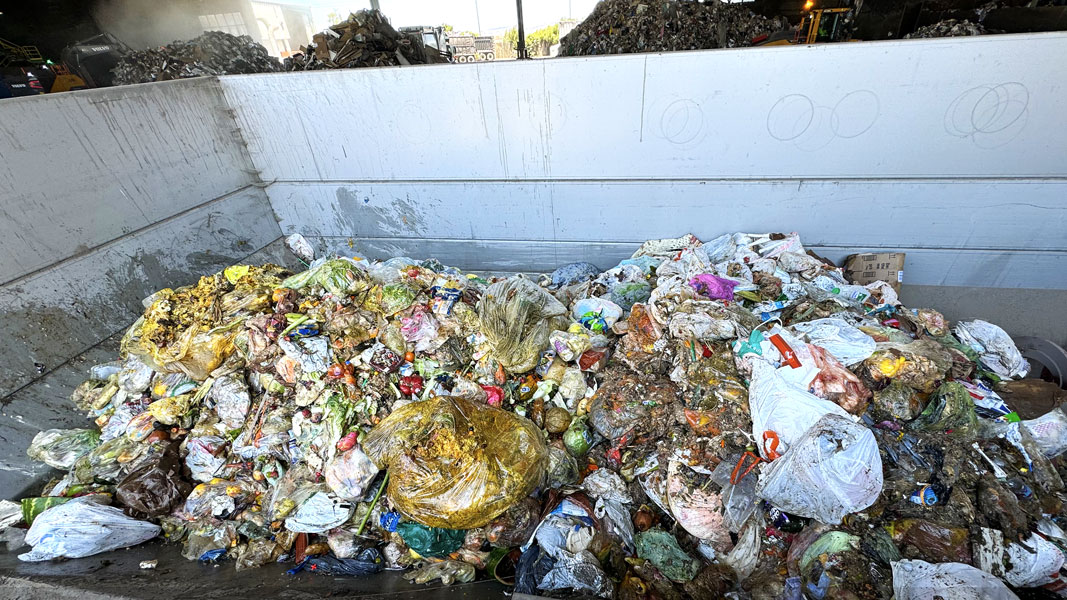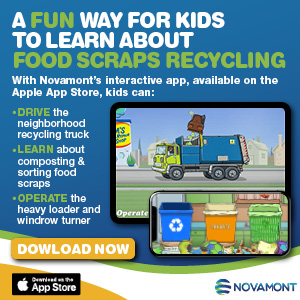Top: The infeed bunker can hold 30 tons of incoming food waste. Photo courtesy City of Sunnyvale, California
Nora Goldstein
In 2017, the City of Sunnyvale, California (pop. ~158,000) initiated a small-scale pilot to collect source separated residential food waste and garbage using a split cart. Initially, a split 50:50 capacity (garbage:food waste) cart was used. “After six months of pilot study and community feedback, we decided to use a cart with a 70:30 split capacity (garbage:food waste) to better reflect household solid waste generation,” explains Deepti Jain, Environmental Program Manager at the City of Sunnyvale’s Solid Waste Division. “Our FoodCycle collection program is helping the city meet its Zero Waste diversion goal of 90% by 2030, and to comply with California’s SB 1383 requirements to divert organic waste from disposal.”
Following the pilot, FoodCycle was rolled out city-wide. Three sizes of split carts are available to residents, based on garbage capacity: 27-gallon, 43-gallon, and 64-gallon. The garbage side of the cart lid is black, and the food waste side of the cart lid is brown. Residential solid waste fees are based on the cart’s garbage capacity. For example, for single-family homes, rates for small, medium and large carts are $80, $92.86, and $109.12 respectively, billed every two months. All household food waste is accepted, including bacon grease, cooking oil, tea bags and coffee filters.
“To increase participation, we initially allowed residents to use compostable or paper bags to help keep their carts clean,” adds Jain. “It didn’t help, so we now allow use of clear produce bags to line the countertop pails. Those bags are the primary source of contamination in the food waste collected, and are removed when the food waste is preprocessed.”
City food scraps collection is also provided to commercial establishments (initiated in 2011) and multi-family residents (initiated in 2022). Currently, about 30,000 single-family households are enrolled in FoodCycle, along with 1,200 multi-family complexes (30,000 units). All restaurants in Sunnyvale, as well as many large cafeterias at technology companies, are serviced by the FoodCycle program. Specialty Solid Waste & Recycling (Specialty) is the contracted trash hauler for the city. Split-body trucks are used to collect garbage and food waste on residential routes. Green waste is collected separately at the curb primarily because the tipping fee for clean material at a composting facility is significantly lower than tipping commingled food and green waste.
Prior to the COVID pandemic, about 8,000 tons/year of food waste were collected. Volumes fell in the first two years of the pandemic (2020 and into 2021), and then began increasing again in 2022. “In 2023 and into 2024, overall tonnages have increased to 10,500 to 11,000 tons annually,” says Jain. “Participation in FoodCycle is mandatory under SB 1383. For single-family, the participation rate is almost 70%.”

The in-ground feed bunker allows trucks to back up and unload directly into the bunker, expediting the time to empty. Photo courtesy City of Sunnyvale, California
Food Waste Preprocessing
When the FoodCycle program was launched in 2017, the city worked with Sustainable Organic Solutions in Santa Clara (CA) to install the vendor’s preprocessing line that included a screen and a “Biopress” to separate food waste from the plastic bags and remove other contaminants. The line was installed at the city’s SMaRT station, which houses a mixed waste processing system and a materials recovery facility. The output was used to make animal feed and fertilizer.
The food waste recovery rate didn’t meet expectations, and the system wasn’t capable of keeping up with the incoming flow of material, causing storage challenges. In 2020, Sunnyvale applied for a CalRecycle Organics Grant to install new food waste preprocessing equipment. The grant program provides funds to support expansion of composting and anaerobic digestion (AD) facilities to achieve greenhouse gas emission reductions. “The city was awarded a $3 million grant in 2022, and then issued a Request for Proposals (RFP) for a depackaging system that also provides adequate storage capacity during preprocessing,” notes Jain. “We had three main objectives to achieve: Increase the recovery of food waste; increase holding capacity so that trucks can unload and leave within 15 minutes; and increase the overall throughput efficiency. Another driving factor is that the Sunnyvale Water Pollution Control Plant (WPCP) is being revamped over the next 20 years. The upgrades will include capacity to codigest food waste with wastewater solids, and a cogeneration plant. The WPCP is adjacent to the SMaRT station, so eventually the slurry from preprocessing can go directly there.” Currently the food waste slurry is codigested under contract at area wastewater treatment plants.
Following a competitive bidding process, the City of Sunnyvale selected Van Dyk Recycling Solutions of Norwalk, Connecticut as the equipment supplier. The preprocessing line includes a storage and feed bunker, a KEITH Walking Floor bin for extra storage capacity and quality control, a SMIMO120 depackager, which acts as the primary separator, a SMIMO15 grinder for further processing, and pumps and conveyors to transport the material between units. The two SMIMO units are manufactured by Smicon and sold by Van Dyk as the exclusive North American supplier. The facility has a holding capacity of 120 tons on site.
The new food waste preprocessing facility began operating in July 2024. (The previous system had been decommissioned in November 2023.) Collection vehicles that service the residential curbside program go across a scale when arriving at the SMaRT Station. They unload garbage first at the mixed waste processing facility, then go back to the scale before tipping the food waste. The in-ground feed bunker allows trucks to back up and unload directly into the bunker, expediting the time to empty (average unloading times are currently around five minutes). The infeed bunker is equipped with three shaftless screws acting as a preliminary mixer to create a homogenous feed for the depackaging unit. Screws have a shaftless design to resist wrapping of contamination. As the screws rotate, material in the bunker gets pushed forward.
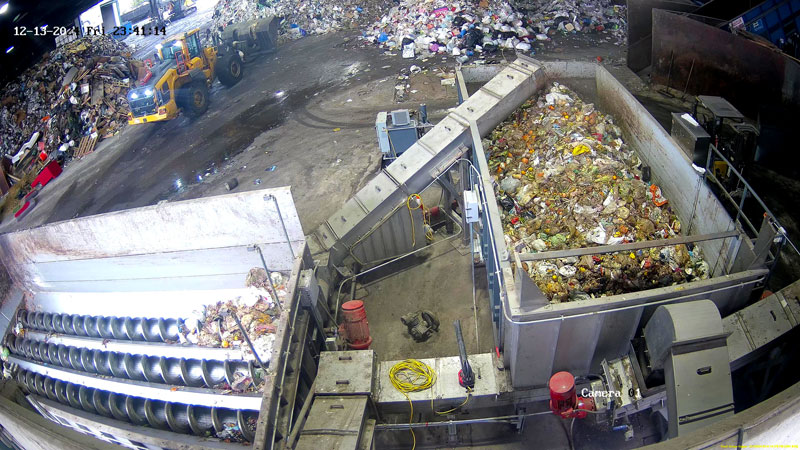
The infeed bunker is equipped with three shaftless screws (left) acting as a preliminary mixer to create a homogenous feed for the depackaging unit. Material is then conveyed to a variable speed KEITH Walking Floor system (right) for storage and visual inspection prior to the depackager. Photo courtesy City of Sunnyvale, California

KEITH Manufacturing supplied the Walking Floor bin that feeds the depackager. Image courtesy KEITH Manufacturing Co.
The material is then conveyed to a variable speed KEITH Walking Floor system for visual inspection prior to the depackager. The Walking Floor bin is 20-feet long and 10-feet wide, with 4-feet deep walls and 30 tons of capacity. A door in the wall provides access to do the visual inspection and remove bulky, non-organic contamination. “The channel flats, walls and a pan to contain liquids under the floor are all stainless steel,” explains Kevin Desjardins at KEITH Manufacturing. “The discharge rate is 16 tons/hour. The floor speed varies from 1-feet/minute up to 4-feet/minute depending on of the feed rate to the depackager.”
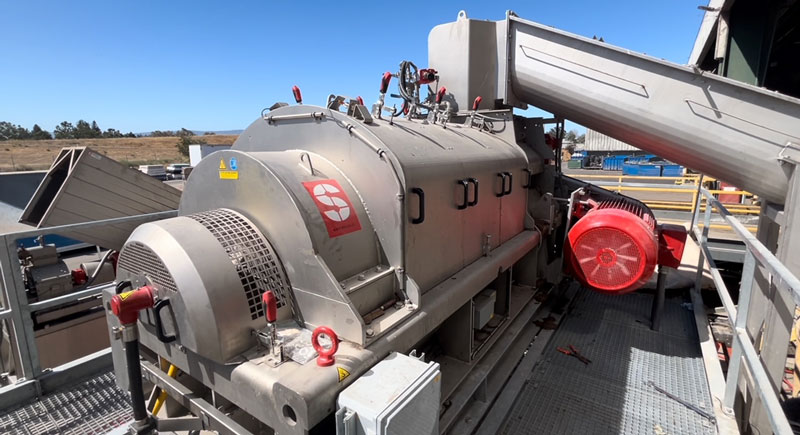
The SMIMO120 depackager has a rotating 360-degree steel drum that separates the organics from any packaging. Photo courtesy of Van Dyk Recycling Solutions
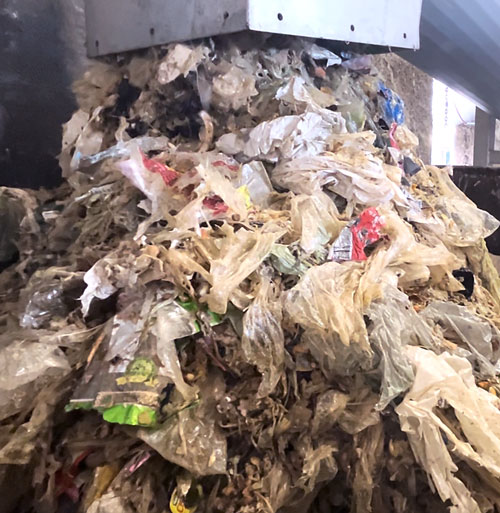
The packaging is expelled and conveyed to a residue container. The organics recovery rate is 85%. Photo courtesy of Van Dyk Recycling Solutions
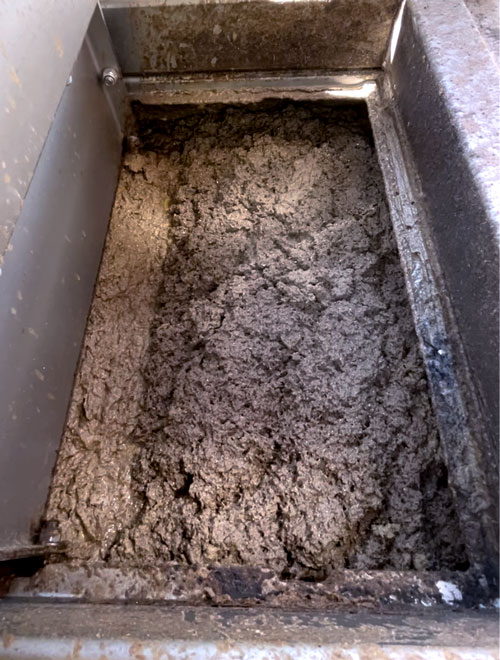
The slurry from the depackager (above) is further processed by a SMIMO15 grinder, which sizes it down to less than half-inch and removes the last bits of grit and glass using a small screen. Photo courtesy of Van Dyk Recycling Solutions
The SMIMO120 depackager has a rotating 360-degree steel drum that separates the organics from any packaging and yields an organic slurry. A dewatering pump at the infeed bunker delivers excess liquid from the bunker to the SMIMO120, eliminating the need for an external water source to process the material. The packaging is expelled and conveyed to a residue container, then disposed in the landfill. The slurry is further processed by a SMIMO15 grinder, which sizes it down to less than half-inch and removes the last bits of grit and glass using a small screen. Heavier particles are “thrown up” into a removal entrapment component by centrifugal force. The depackager achieves greater than an 85% recovery of organics.
“This system has been an all-around success at increasing throughput, increasing storage capacity, and increasing the recovery of organics,” notes Kevin Brogan, a process engineer at Van Dyk Recycling Solutions.
Pumps and storage tanks play a major role in materials handling at the facility. “There are three large tanks to store the slurry, which have a total of 60 tons of storage capacity,” notes Jain. “The slurry from the depackager is pumped to the first tank, and from there, it is pumped to the grinder. After grinding the slurry is pumped to two slurry storage tanks. Finally, a main truck pump can empty all three tanks at any time to a tanker truck going to either Silicon Valley Clean Water in Redwood City or the East Bay Municipal Utility District in Oakland for codigestion. We have a third contract with Central Marin Sanitation Agency in San Rafael in case we need a backup digestion option.”


